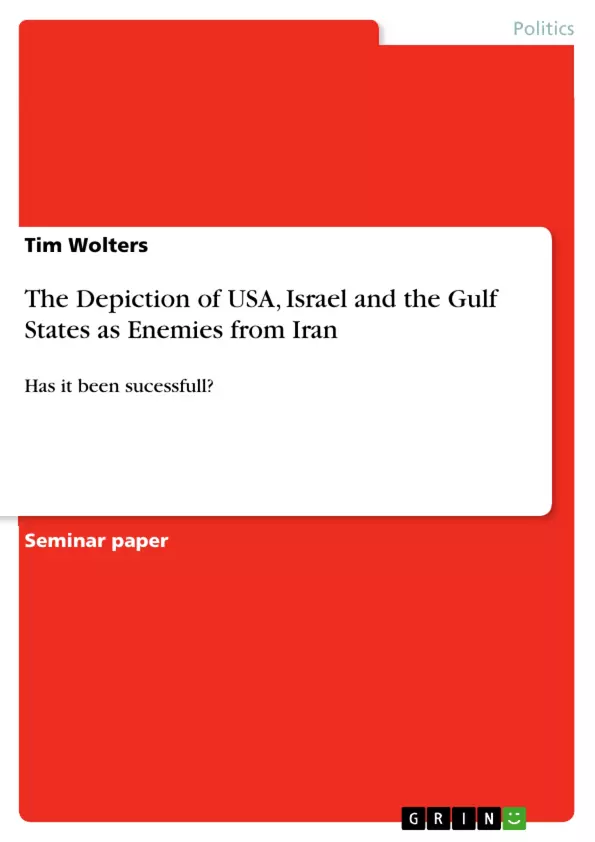With the Islamic Revolution in 1979 in Iran, one of the biggest shifts in the power structure of the Middle East Region happened. Suddenly, from one day to the other, the United States of America (USA) and its allies lost one of their major Ally’s in the Region. Since then, the USA and their allies, mostly Saudi-Arabia, the United Arab Emirates and Israel are in a power struggle with Iran about the control of the Middle East. Since 2017, the tensions between Iran and the US and its allies reaching new highs after the withdraw of the US from the Joint Comprehensive Plan of Action (JCOPA) treaty in 2018 and the also growing involvement of Iran in the Syrian Civil War to support the alliance between Iran, Syria and the Hezbollah and establishing a long term presence in Syria. In the last Month the Iran and the USA where on the verge of War when Iran first shut down an United States (US) spy drown and just a month later, sizing a British Oil tanker in the Strait of Hormuz, which brought the tensions with the West and its allies to a new high.
These meaningful events in the last 2 years and beyond are the reasons why Iran’s foreign policy is so relevant and interesting for the scientist research at the moment, because it is not completely clear how Iran is justifying the US and their allies as enemies of Iran and why this approach in foreign policy is therefore so different and unique to other, mainly Arabic states in the Region.
Inhaltsverzeichnis (Table of Contents)
- Iran: A unique foreign policy in the MENA Region...
- Securitization Theory and the apply on Iran's foreign policy measures.
- The Securitization Theory.
- Analysis of Iran´s foreign policy securitization since 2011
- Context and Preconditions
- Syria...
- Joint Comprehensive Plan of Action
- Conclusions.
Zielsetzung und Themenschwerpunkte (Objectives and Key Themes)
This paper aims to analyze how Iran portrays the USA, Israel, and the Gulf states as its enemies and to what extent it has been successful. It focuses on the unique foreign policy of Iran, which differs from other Arab states in the region, and examines how Iran justifies its actions through the lens of the Securitization Theory.
- Iran's unique foreign policy in the MENA Region
- The role of the Securitization Theory in understanding Iran's foreign policy
- Iran's depiction of the US, Israel, and the Gulf states as enemies
- The effectiveness of Iran's securitization strategies
- Case studies of Iran's foreign policy in Syria and the Joint Comprehensive Plan of Action (JCPOA)
Zusammenfassung der Kapitel (Chapter Summaries)
The first chapter introduces the context of Iran's foreign policy in the MENA region, highlighting the shift in power dynamics after the Islamic Revolution of 1979. It establishes the central research question: How does Iran depict the USA, Israel, and the Gulf states as its enemies and to what extent has it been successful? The chapter also presents the hypothesis that Iran uses its perceived enemies as justification for extraordinary foreign policy measures to secure its national security.
Chapter two dives into the theoretical framework of the Securitization Theory, explaining how security threats are constructed and mobilized through specific social processes. The chapter explores the key elements of the theory, including securitizing actors, moves, audiences, and preconditions, highlighting its application in analyzing Iran's foreign policy.
This preview does not include the chapter summaries for "Conclusions" and "Bibliography." These are not part of the body of the text and may contain spoilers or reveal significant information about the research findings.
Schlüsselwörter (Keywords)
This paper centers on the key concepts of Iranian foreign policy, securitization theory, national security, the Middle East & North Africa (MENA) region, the USA, Israel, the Gulf states, Syria, and the Joint Comprehensive Plan of Action (JCPOA).
- Citation du texte
- Tim Wolters (Auteur), 2018, The Depiction of USA, Israel and the Gulf States as Enemies from Iran, Munich, GRIN Verlag, https://www.grin.com/document/994254



